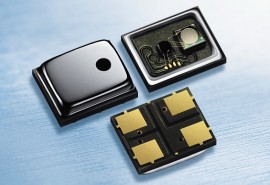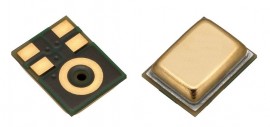What is a MEMS Microphone: Analog vs Digital

In audio technology, MEMS microphones stand out as a remarkable innovation, seamlessly merging micro-electro-mechanical systems (MEMS) and application-specific integrated circuits (ASIC) into a compact package. These miniature marvels are transforming sound capture, offering exceptional performance and versatility. This article delves into MEMS microphones, their underlying technology, and their applications in the audio industry.
What are MEMS Microphones?
MEMS microphones are crafted using advanced micro-electro-mechanical systems processing techniques, often called microphone chips or silicon microphones. Their ingenuity lies in the intricate design etched onto a semiconductive silicon wafer.
A pressure-sensitive diaphragm is positioned behind a stationary perforated plate at the core of a MEMS microphone, creating a capacitor reminiscent of condenser microphones. This manufacturing process employs semiconductor silicon wafers and highly automated processes. Layers of different materials are precisely stacked on the silicon wafer, with excess material expertly etched away, resulting in a transducer element featuring a movable diaphragm, a stationary perforated plate, and a protective housing.
The Role of ASICs
A custom-designed application-specific integrated circuit (ASIC) is employed to complement the transducer element. This ASIC utilizes a charge pump to establish a fixed charge between the stationary plate and the microphone membrane. Essentially, the core structure of a MEMS microphone closely resembles that of an electret condenser microphone (ECM).
The transducer component, combined with the ASIC, is mounted on a printed circuit board (PCB) and safeguarded by a mechanical cover with a small aperture, allowing sound access to the microphone element. Soundwaves travel through the casing and the perforated plate before reaching the MEMS diaphragm.
Enhanced Functionality
Modern MEMS microphones often incorporate a second semiconductor die (integrated circuit), functioning as an audio preamplifier, significantly boosting microphone performance.
In digital MEMS microphone designs, a metal-oxide-semiconductor (CMOS) chip typically acts as an analog-to-digital converter (ADC). These chips efficiently convert amplified analog audio signals into digital data, simplifying integration with digital devices. Pulse density modulation (PDM) is the prevalent format for digital encoding within MEMS microphones, offering cost-effective solutions for PDM signal receivers.
How MEMS Microphones Work
In this section, we explore the intricate workings of MEMS (Micro-Electro-Mechanical Systems) microphones, vital components in various applications. Understanding their functionality requires breaking down the key components and processes involved.
Key Components of a MEMS Microphone
A MEMS microphone comprises several crucial components, each playing a pivotal role in capturing and converting sound waves into electrical signals:
- MEMS Transducer Element: At the core of a MEMS microphone lies the transducer element, composed of a diaphragm/membrane, a perforated stationary plate, and a protective housing. This diaphragm is responsible for converting sound into an electrical signal.
- Printed Circuit Board (PCB): The PCB serves as the platform on which the MEMS microphone assembly rests, incorporating the Application Specific Integrated Circuit (ASIC), mic preamplifier, and analog-to-digital converter (ADC), critical for signal processing.
- Mechanical Cover: The microphone features a mechanical cover that acts as a shield, allowing sound waves to enter while protecting the delicate internal components.
Sound-to-Signal Conversion
Sound waves entering the MEMS microphone penetrate the mechanical cover and travel through the perforated housing to reach the diaphragm/membrane. The diaphragm responds to varying sound pressure, moving in harmony with incoming sound waves. A charge separation must occur between the conductive diaphragm and the stationary plate to translate this movement into an electrical signal, effectively creating a capacitor. The ASIC provides the critical charge for this process.
Once charged, the diaphragm and plate generate a voltage. As a capacitor, any change in the distance between them results in a corresponding voltage change, producing an alternating current (AC) voltage constituting the microphone signal.
Signal Amplification
To make this voltage useful as an audio signal, an integrated circuit on the PCB amplifies it. In analog MEMS microphones, this amplified signal is directly outputted. In the digital realm, an Analog-to-Digital Converter (ADC) is employed to convert the analog signal into a digital audio signal, typically using Pulse-Density Modulation (PDM). This digital output suits modern digital devices.
Fine-Tuning for Optimal Performance
MEMS microphones are meticulously engineered devices, with design choices such as diaphragm and backplate configurations, port orientation (top or bottom), and the presence of perforations significantly impacting microphone performance. Ventilation holes maintain ambient pressure within the back chamber, further refining microphone performance. Perforations, whether behind the diaphragm or in the protective shell, can be included to shape the microphone's directional polar pattern.
In summary, MEMS microphones are a fascinating engineering and technology synergy, making sound into electrical signals with precision. Their diverse designs cater to various applications, making them indispensable in today's audio technology landscape.
Exploring MEMS Microphone Technology
In the dynamic realm of audio technology, MEMS (Micro-Electro-Mechanical Systems) microphones have carved a prominent niche, offering unparalleled precision in sound capture. Let's delve into the world of MEMS microphone technology, focusing on the core elements that make it an industry frontrunner.
Capacitive Sensor Technology: The Cornerstone
Most MEMS microphones rely on capacitive sensor technology, an ingenious system that converts sound waves into electrical signals with utmost fidelity.
The Vibrating Membrane: Responsive to Sound
A thin, plated membrane integrated into the silicon structure is fundamental to capacitive MEMS microphones. This membrane can vibrate in response to incoming sound waves, acting as the frontline sensor for audio capture.
The Capacitor's Crucial Role
Central to capacitive technology is using a capacitor with two integral components. The vibrating membrane serves as one plate, while the second plate remains fixed within the silicon structure. This fixed plate's stability is paramount during the sound-capturing process.
Generating Voltage: The Charge Pump
To facilitate the transformation of capacitance changes into electrical signals, an integrated circuit (IC) with a charge pump is employed. This IC generates a high DC voltage, ensuring the capacitor functions optimally to translate the audio signals detected by the vibrating membrane.
Translating Fluctuations into Sound Signals
As sound waves interact with the responsive membrane, they induce fluctuations in capacitance. These fluctuations, born from the membrane's movement in response to sound, serve as a direct reflection of the incoming audio signals.
Converting Capacitance Changes: The IC Circuitry
The brilliance of capacitive MEMS microphone technology extends to the realm of IC circuitry. This intricate circuitry interprets capacitance changes, resulting in the generation of electrical signals representing the captured audio signal with precision.
Exploring Alternatives: Piezoelectric Sensing
While capacitive technology reigns supreme, some manufacturers have ventured into using piezoelectric sensing elements. These elements harness the motion of piezoelectric components to produce audio voltage. However, for most applications, the choice between capacitive and piezoelectric technologies may not significantly impact overall performance.
Demystifying "Silicon Microphones"
Lastly, the term "silicon microphone" is often used interchangeably with silicon-based MEMS microphones. It's essential to clarify that this is not a distinct technology but rather an alternate nomenclature for silicon-based MEMS microphones, which operate on the same underlying principles of capacitive sensor technology.
MEMS microphone technology, predominantly rooted in capacitive sensor innovation, stands as a pinnacle of precision and sensitivity in sound capture. Through the harmonious interplay of vibrating membranes, capacitors, and sophisticated IC circuitry, these microphones excel in transforming acoustic waves into faithful electrical representations. While alternative technologies exist, capacitive MEMS microphones continue to lead the way, delivering versatile and high-quality performance across diverse applications.
Analog vs. Digital MEMS Microphones
The choice between analog and digital MEMS microphones depends on the specific application's demands. Analog MEMS microphones produce an output voltage proportionate to the instantaneous air pressure level, often augmented by an internal amplifier chip for analog processing. They are suitable for applications like simple loudspeakers and radio communication systems. However, meticulous design is essential to mitigate noise between the microphone output and the receiving IC input in analog signal scenarios.
On the other hand, digital MEMS microphones excel in converting analog voltage signals into a digital bitstream, employing an Analog-to-Digital Converter (ADC) followed by pulse density modulation (PDM) encoding. They are especially well-suited for scenarios where the host device is a microcontroller (MCU) or a digital signal processor (DSP). Digital MEMS microphones offer advantages in noise immunity, bit error tolerance, and a simplified hardware interface.
The decision between analog and digital MEMS microphones is guided by the intricacies of the end application, particularly in how the output signal will be utilized.
MEMS Microphone Applications
MEMS microphones offer numerous benefits, including small size, high performance, and flexibility for customization, making them ideal for various applications, particularly in consumer electronics where size and power efficiency are critical.
Common consumer electronic uses for MEMS microphones include smartphones, smart speakers, desktop and laptop computers, tablets, and hearing aids. These microphones provide good signal-to-noise ratio (SNR) performance in a compact package, often used in multi-microphone configurations for capturing sound inputs from various directions.
MEMS microphones are particularly valuable for battery-powered devices, maximizing energy efficiency. Their production flexibility allows for scale customization, making them a cost-effective choice for various application needs.
Comparing MEMS Microphones and Electret Condenser Microphones
In exploring microphone technology, we delve into the distinctive characteristics of MEMS (Micro-Electro-Mechanical Systems) microphones and Electret Condenser Microphones (ECMs). Both share a foundation rooted in electrostatic principles, employing capacitor-based capsules featuring a movable diaphragm and a stationary plate, with applications in consumer and professional electronics.
MEMS Microphones: Pioneering Miniaturization and Precision
MEMS microphones excel with compactness, integrated PCBs and ADCs, low impedance for noise rejection, resilience to vibrations, and continuous advancements, making them ideal for space-constrained applications demanding high-quality audio capture.
Electret Condenser Microphones: Versatility and Legacy Appeal
ECMs remain valuable for legacy integration, diverse connectivity options, environmental resilience, directional flexibility, and voltage tolerance. They are preferred for seamless upgrades and backward compatibility and excel in various scenarios with established designs.
The choice between MEMS microphones and ECMs depends on the application's precise demands, legacy systems, and environmental considerations. MEMS microphones offer compactness and high performance, while ECMs provide versatility and compatibility with established designs.
Why FHD is Your Go-to MEMS Microphone Suppliers
Partnering with reputable MEMS microphone suppliers is essential to harness this technology's benefits effectively.
FHD Electronic Corporation is a leading manufacturer of fully customized MEMS microphones. They offer customization based on system design and performance requirements, ensuring the creation of bespoke MEMS microphones with cutting-edge quality and efficiency. FHD is committed to maintaining the highest quality standards, innovative R&D, and customer satisfaction.
In addition, FHD provides comprehensive support throughout the MEMS microphone supply chain, from system requirement identification to device distribution and delivery. This full lifecycle support sets FHD apart as a dependable partner in the MEMS microphone industry.
Now equipped with insights into MEMS microphones, explore FHD's MEMS microphone lineup below and initiate your order today, anticipating a fruitful partnership.
Exploring FHD's MEMS Microphone Lineup
Here's a glimpse into FHD's exceptional MEMS microphone lineup, each meticulously designed to cater to diverse audio needs and applications. Discover the perfect microphone to elevate your audio experience:
| Model Number | Image | Dimensions | Directivity | Sensitivity (dB) | Operating Voltage Range | Output Types | Signal/Noise Ratio |
| PM372911-OS423 |  |
3.72 x 2.95 x 1.1mm |
Omni-directional |
-42±3d | 1.5V~3.3V |
Analog |
more than 59dB |
| PM373011-OS383 |  |
3.76 x 3 x 1.1mm | Omni-directional | -38±3d | 1.5V~3.6V |
Analog |
more than 59dB |
| PM352610-OS382 |  |
3.5 x 2.65 x 0.98mm | Omni-directional | -38±2d | 1.5V~3.6V |
Analog |
more than 59dB |
| PM372211-OS423 |  |
3.76 x 2.24 x 1.1mm | Omni-directional | -42±3d | 1.5V~3.6V |
Analog |
more than 59dB |
Ready to Elevate Your Audio Experience?
Explore FHD's range of MEMS microphones today and discover precision, performance, and versatility like never before. Contact our team now to discuss your unique requirements and find the perfect audio solution for your needs.
Let's amplify your audio journey together. Contact us at +1-469-409-2828, email us at sales@fhdmfg.com, or fill out the inquiry form. Your sound, our expertise - let's make it happen!
Reference:
- https://www.allaboutcircuits.com/technical-articles/introduction-to-microelectromechanical-systems-microphone-technology/
- https://www.coventor.com/blog/explanation-new-mems-microphone-technology-design/

